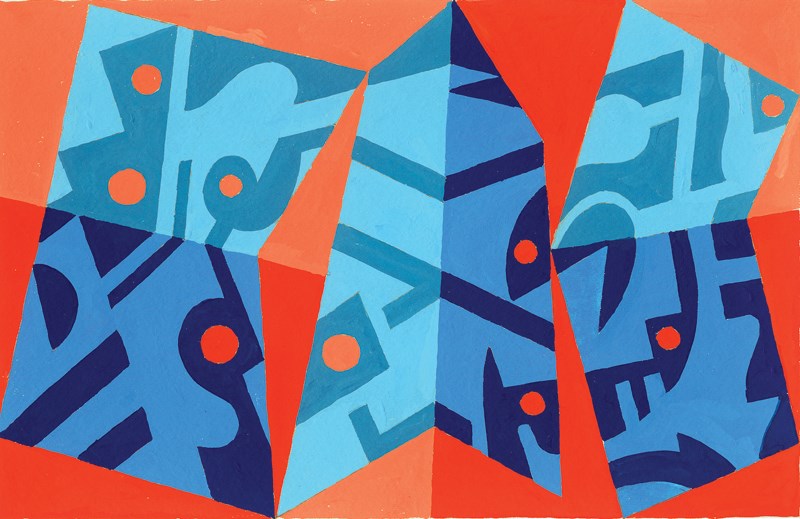Eric Metcalfe: Gargoyles and Improvisations, West Vancouver Museum. Opening Reception: Sept. 19, 7–9 p.m. Artist Talk: Sept. 30 at 2 p.m. For more information visit westvancouvermuseum.ca.
Each year the town offered a sacrifice to the dragon.
Usually it was a convict but sometimes the fire-breather, La Gargouille, got a virgin.
But something changed in town. Maybe the chamber of commerce brainstormed on increasing tourism, maybe ethical qualms sprang up around fiery capital punishment. Whatever the reason, the townsfolk of Rouen, France looked to a Christian priest.
Knowing him and knowing how he earned his living, the townspeople paid the priest by building a church.
As the church rose near the Seine, the priest found the dragon, transfixing it with the sign of the cross.
The man of the cloth tethered the dragon with a leash made of “priestly garments” before burning the creature of flame at the stake, according to folklorist Gary R. Varner’s version of the tale.
Everything turned to ash but its head and neck.
So, to alert townsfolk to the evils that lurked outside the house of salvation, the remains of the monster was mounted on the church wall.
La Gargouille, so the story goes, became the first gargoyle.
There was something fascinating about those fantastic beasts, according to artist Eric Metcalfe. They were an architectural detail sculpted to ward off evil while functioning as a drainpipe.
“Those creatures are part devil, part angelic,” he says. “We all have our totems.”
In creating his totems for Gargoyles and Improvisations, Metcalfe subjected the classical form to his interests and obsessions.
“I made them into a more modern, updated version of what I would do.”
The result is geometric progressions of colourful near-parallelograms that elude recognition until the viewer cranes their neck to just the right angle.
Sometimes eyes or teeth stare back, sometimes a yellow and black pattern recalls Metcalfe’s days as Dr. Brute, the art world’s leading proponent of leopard print.
Metcalfe laughs in memory of plastering the Vancouver art gallery with leopard print.
“It became quite political,” he says, discussing the artistic climate of the late 1960s and early ’70s.
In conversation with Metcalfe, one phrase seems to recur: “I could go on about that one.”
He has volumes to say about architect Arthur Erickson, artist Emily Carr, and director Otto Preminger.
If Usain Bolt ever needed a guide through a modernist museum, Metcalfe would be the guy. He’s enthusiastic, speaking rapidly and with depth. However, his greatest enthusiasm seems reserved for jazz.
In 1955, as the world of modernism seemed to crumble, Metcalfe was 15.
“The abstract expressionism was winding down by the mid ’50s with the death of a Jackson Pollock, which was sort of a signpost of that end, Charlie Parker died in 1955, Dylan Thomas died in 1953, Black Mountain College came to an end.”
But what a trove they left for him to sift through.
There were poets, paintings and records; particularly Blue Note records featuring Thelonious Monk and Miles Davis.
“I was fascinated by the record covers because there was such good writing on them,” he notes. “The Blue Note covers were masterpieces of design.”
There were also those non-musical bebop devotees like Jack Kerouac and Allenn Ginsberg who did their best to translate the howl of jazz cats onto paper.
“That became a part of my visual language,” he explains.
Drawing to music it is something he still does, he says, clarifying he’s more beat than a hippie.
“It inspires me,” he says.
The only time Metcalfe seems stumped is when asked how he thinks the audience might respond to his work.
“You never know what an audience is going to think. People are not that sophisticated in Vancouver, I mean, they’re more interested in buying their second Range Rover, they’ve not interested in buying culturing art.”
The topic leads Metcalfe into the cost of housing in Vancouver, which is sapping the town’s vibrancy, he says.
“It’s just nuts, man. You think of young people trying to come up in that situation and live in Vancouver, it’s become impossible so they go to Montreal or go to Europe, and it’s gutting a whole generation.”
At the conclusion of our wide-ranging conversation, Metcalfe wishes me well in writing a story.
“I don’t know how you make any sense of that.”



